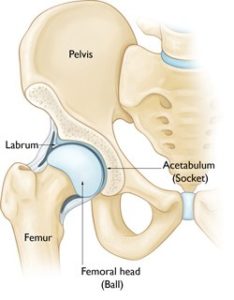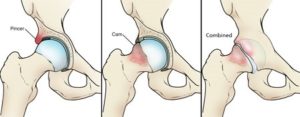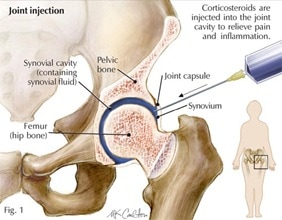Chiropractor Dr. Stephen Szaro explains the different causes of hip impingement and the various modalities used to treat hip pain.
Hip impingement, also known as femeroacetabular impingement (FAI), is a common condition in which there is extra bone growth along one or both of the bones that form the hip joint.
This gives the bones of the hip an irregular shape causing the bones to rub into the hip joint causing irregular wear and tear. Over time this friction can damage the cartilage of the hip leading to early onset degeneration of the hip joint.
Anatomy of the Hip
The hip is a ball and socket joint created by the head of the femur and the acetabulum which sits inside the pelvis. Between the two bones is cartilage which provides a cushion and frictionless surface for the joint to move across. There is a ring of fibrocartilage around the acetabulum called the labrum. The labrum acts as a seal around the joint creating stability.
Causes of Hip Impingement
In FAI, the overgrowth of bone, or bone spur, can form along the femoral neck below the femoral head or along the acetabulum. When extra bone is laid down on the femur it is called a cam impingement. When the bone spur forms along the acetabulum it is referred to as a Pincer impingement. Both pincer and cam impingement can also be present together, which is called a combined impingement.
When these bone spurs form it causes abnormal contact between the bones of the hip and prevents the joint from moving smoothly. This friction can result in tears to the cartilage and the labrum of the hip resulting in early onset osteoarthritis.
It is important to know that this condition usually begins during childhood. The bones of this hip generally do not form properly and thus there is very little that can be done in terms of prevention.
Treatment for Hip Impingement
At Physio Logic we treat this dysfunction in several ways. It is important to start any therapy as early as possible. Research has found that a hip impingement will lead to early onset hip degeneration.
Myofascial release techniques and sports massage techniques like Active Release Techniques (ART) and Graston instrument-assisted soft tissue mobilization have proved to be extremely effective in breaking down scar tissue. These treatments help in releasing tight muscles around the hip, increasing range of motion, and increasing blood flow to stimulate healing.
Corrective exercises that focus on strengthening the gluteal complex and the spine are also imperative to ensure proper and smooth motion of the hip joint to prevent further damage.
Chiropractic manipulative therapy can also be helpful in created better motion in the joints of the lower back, pelvis and hip.
In some cases, steroid injections are needed in order to reduce inflammation and decrease the amount of wear happening in the joint. This will usually alleviate pain and inflammation in order to facilitate further rehabilitation.
If you have been diagnosed with hip impingement or have been dealing with hip pain a proper evaluation is necessary. Many athletes and the general population who deal with chronic hip pain can perform at higher levels and lead better lives once proper therapy has been completed.



